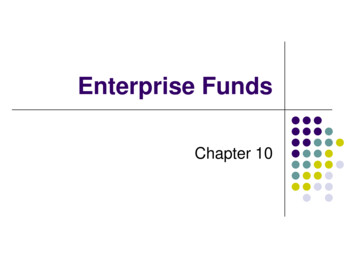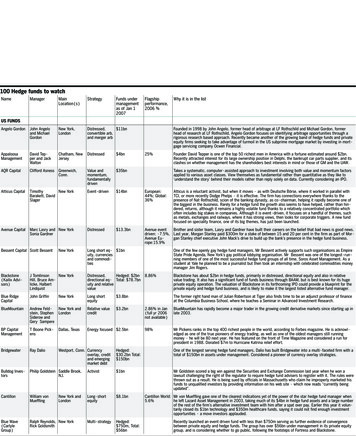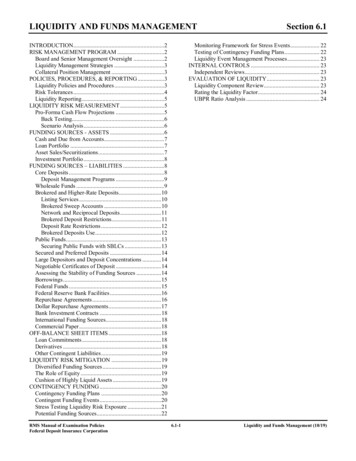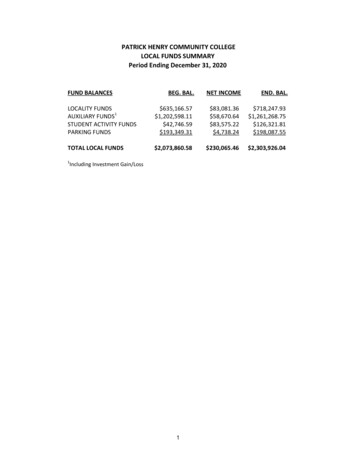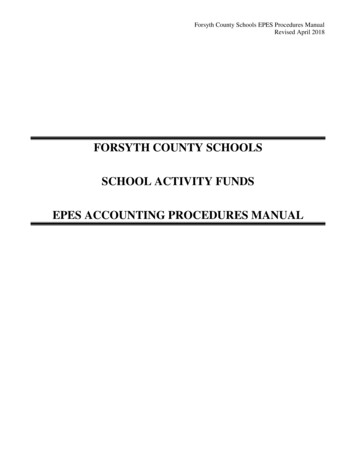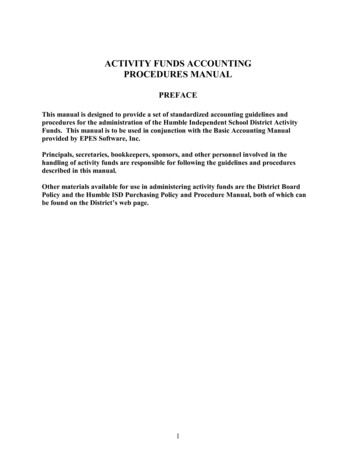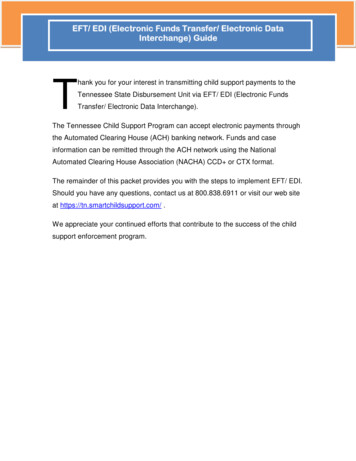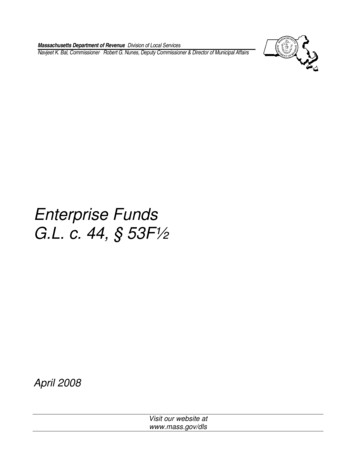
Transcription
Massachusetts Department of Revenue Division of Local ServicesNavjeet K. Bal, Commissioner Robert G. Nunes, Deputy Commissioner & Director of Municipal AffairsEnterprise FundsG.L. c. 44, § 53F½April 2008Visit our website atwww.mass.gov/dls
Enterprise FundsG.L. Chapter 44, § 53F½TABLE OF CONTENTSSignificant Rule Changes . 1Introduction . 2Brief History . 2What is an Enterprise Fund . 2Why Adopt and Enterprise Fund. 2What Governmental Entity May Adopt Enterprise Fund Accounting . 3For What Services Can a Community Adopt An Enterprise Fund . 3Adopting an Enterprise Fund . 4The Enterprise Budget. 5Revenues of an Enterprise Fund . 5Available Funds of an Enterprise Fund. 5Expenses of an Enterprise Fund . 7Balancing an Enterprise Budget . 8Adopting an Enterprise Budget. 10Reporting on Schedule A-2 and the Tax Rate Recapitulation Forms . 12UMAS Accounting Entries . 28Frequently Asked Questions. 34Appendix A: G.L. c. 44, § 53F½. 40Appendix B: A Retained Earnings Deficit . 41LIST OF TABLESTable 1: Three Scenarios for an Enterprise Budget . 8Table 2: Budget Presentation Examples . 9Table 3: Budget Recommendation Wording. 10Table 4: Budget Order/Article Wording. 11Table 5: Schedule A-2, Enterprise Funds, Page 1 . 12Table 6: Schedule A-2, Enterprise Funds, Page 2 . 13Table 7: Certification of Appropriations and Sources of Funding . 20Table 8: Tax Rate Recapitulation Form, Page 2. 24Division of Local ServicesTable of Contents
Enterprise FundsG.L. Chapter 44, § 53F½Informational Guideline Release (IGR) No. 08-101April 2008Supersedes June 2002 Enterprise Fund ManualandAny Prior Written Inconsistent StatementsENTERPRISE FUNDS(G. L. c. 44, § 53F½)These guidelines provide guidance to local officials on the use of an enterprisefund under G.L. c. 44, § 53F½ to separately account for municipal services of aproprietary nature, i.e., those services provided to individual customers for a charge in amanner similar to private business.The guidelines prescribe uniform accounting standards for enterprise fundrevenues and expenditures. They also set forth the policies that apply to the review ofenterprise budgets for tax rate setting purposes. G.L. c. 44, §§ 38 and 43; c. 59, § 23.These standards and policies are effective as of June 30, 2008 and supersedethose found in the June 2002 Enterprise Fund manual and any prior written inconsistentpublications or statements.BUREAU OF ACCOUNTSDivision of Local ServicesGERARD D. PERRY, DIRECTORTable of Contents
Enterprise FundsG.L. Chapter 44, § 53F½SIGNIFICANT RULE CHANGESThe following are significant rule changes incorporated in these guidelines. Their effective date isJune 30, 2008. Use of retained earnings. Retained earnings may be appropriated to:1. fund direct costs of the enterprise for the current fiscal year;2. fund costs appropriated in the General Fund operating budget and allocated to theenterprise for the current fiscal year;3. reimburse to the General or other fund for subsidized capital costs of the enterprise notalready reimbursed for the two full, immediately prior, fiscal years. Reporting of a retained earnings reimbursement. Retained earnings appropriated specificallyto reimburse the General Fund for subsidized capital costs should not be reported on page 4of the Tax Rate Recap (similar to a vote from free cash to reduce the tax rate) or on ScheduleA-2. Instead, the amount should be reported in Part IIID, line 4 of the Tax Rate Recap. If soreported, city/town Clerks are advised to provide a copy of the vote to the Bureau of Accountsfor tax rate certification purposes. Funding a retained earnings deficit. A retained earnings deficit for the period ending June 30must be reported and funded in the next fiscal year’s tax rate. A community no longer needsto report and fund an enterprise fund revenue deficit. A retained earnings deficit must beraised from the tax levy as a General Fund subsidy unless the community:1. appropriates from the General or other applicable fund specifically for the purpose offunding the deficit; or2. increases enterprise estimated revenues above the amount appropriated for enterprisedirect and indirect expenses, provided the additional estimated revenues can beproperly supported. Indirect cost allocation methodology. The Bureau recommends that every community with anenterprise fund establish a written, internal policy regarding indirect cost allocation and shouldreview this policy annually. The policy should be reasonable and calculated in a fair andconsistent basis. Local financial officials should understand and agree on what indirect costsare appropriated as part of the General Fund operating budget and what percentage of thesecosts should be allocated to the enterprise fund.The Director of Accounts may reject any community’s methodology, written or otherwise, asunreasonable for tax rate setting purposes. Appropriation for indirect costs. Indirect costs are generally appropriated as part of theGeneral Fund operating budget and are allocated to the enterprise fund as reported onSchedule A-2. Do not appropriate these costs in both the General Fund operating budget andin the enterprise fund budget. Local financial officials may wish to show the public all costs ofthe enterprise fund, but should not duplicate their appropriation. Therefore, reporting ofenterprise fund estimated receipts on page 3 of the Tax Rate Recap to offset any duplicationshould no longer be necessary. In the Bureau of Accounts’ FY2007 end-of-year letter, the Bureau advised that “should afund balance deficit occur as of June 30, 2007 and as of June 30, 2008 (two consecutiveyears), General Fund free cash as of June 30, 2008 will be reduced by the enterprise funddeficit balance.” The policy has been revised and a General Fund reduction will not occur.Division of Local Services1Introduction
Enterprise FundsG.L. Chapter 44, § 53F½INTRODUCTIONBRIEF HISTORYThe enterprise fund statute, G.L. c.44, § 53F½, was initially enacted in 1986 (see Appendix A).Before then, communities used special revenue funds authorized by various general laws or specialacts to separately account for their business type services. These special revenue funds were limited,however, with regard to the services and costs covered. The funds were most commonly authorizedfor water, gas and electric utility departments and used primarily to account for annual operatingcosts, not the indirect costs, capital improvements or fixed assets of the service.WHAT IS AN ENTERPRISE FUNDAn enterprise fund gives communities the flexibility to account separately for all financial activitiesassociated with a broad range of municipal services. It establishes a separate accounting andfinancial reporting mechanism for municipal services for which a fee is charged in exchange for goodsor services. Revenues and expenses of the service are segregated into a fund with financialstatements separate from all other governmental activities. (See Uniform Massachusetts AccountingSystem (UMAS) chapter 12 for more information including illustrative journal entries).WHY ADOPT AN ENTERPRISE FUNDA community may account for certain services in the General Fund, special revenue or enterprisefund. Advantages of an enterprise fund include that it: Identifies a total service cost – Consolidating direct operating, direct capital, and indirect costs(e.g., enterprise-related costs appropriated in the General Fund operating budget) helps acommunity to readily identify a total service cost and determine funding sources. The total servicecost may also include a subsidy from the General or other fund or a reimbursement from theenterprise fund to other funds for subsidized costs incurred in the two full, immediately prior fiscalyears. Provides useful management information – Consolidating revenues, expenses and operatingperformance of the fund provides a community with useful decision making information regardinguser charges and fees and a subsidy if necessary. The community can also include the enterprisefixed assets and infrastructure as assets and recognize the annual depreciation of these assets inaudited financial statements. Retains investment income and surplus – All investment earnings and any operating surplus(actual revenues in excess of estimates and appropriations in excess of expenses) are retained inthe enterprise fund rather than closed to the General Fund at fiscal year-end. Surplus certified bythe Director of Accounts as available is called “retained earnings”. Retained earnings requireappropriation by the community’s legislative body and have certain other use restrictions as will benoted in these guidelines.Division of Local Services2Introduction
Enterprise FundsG.L. Chapter 44, § 53F½WHAT GOVERNMENTAL ENTITY MAY ADOPT ENTERPRISE FUND ACCOUNTINGOnly Massachusetts cities and towns may adopt an enterprise fund pursuant to G.L. c.44, § 53F½.Regional school, vocational-technical school and/or special purpose districts may not adopt anenterprise fund, unless permitted by special legislation.FOR WHAT SERVICES CAN A COMMUNITY ADOPT AN ENTERPRISE FUNDEnterprise funds may be established, “for a utility, health care, recreational or transportation facility.”Examples include: Public utilities – water, sewer, trash disposal;Health care – ambulance service, nursing homes;Recreation – skating rinks, pools, golf courses; andTransportation – airports, dock and wharf facilities.A community may not establish enterprise funds for normal government operations or services suchas public safety, inspectional services or cemeteries.Division of Local Services3Introduction
Enterprise FundsG.L. Chapter 44, § 53F½ADOPTING AN ENTERPRISE FUNDA city or town may adopt an enterprise fund by vote of the legislative body, subject to the localcharter. Each enterprise fund must be adopted separately with its own vote. This allows thelegislative body to identify and evaluate each enterprise on its own merits.The following is sample language to adopt an enterprise fund.“To see if the (city or town) will accept the provisions of Chapter 44, § 53F½ of theMassachusetts General Laws establishing (the service) as an enterprise fund effectivefiscal year (year).”The language of the vote should clearly state what the service is and when the fund will commence.The Bureau of Accounts recommends that commencement begin at the start of a fiscal year. If acommencement date is absent, the Bureau recommends that the enterprise commence on thefollowing July 1. However, the Bureau will allow an enterprise fund to commence after July 1 ifadopted after July 1, but prior to Bureau certification of the tax rate. After that time, commencementof an enterprise fund must be deferred to July 1 of the next fiscal year.Once adopted, the community begins the process of establishing the separate fund on its accountingrecords and identifying the assets (capital items and infrastructure), liabilities and equity in other fundsif voted by the legislative body to be transferred to the enterprise fund.The community must operate the enterprise fund for a minimum of three years before the provisionsmay be rescinded like any local adoption law.Division of Local Services4Adopting an Enterprise Fund
Enterprise FundsG.L. Chapter 44, § 53F½THE ENTERPRISE FUND BUDGETThe entity responsible for operating the enterprise must submit to the local executive authority aproposed line item budget “no later than one hundred and twenty days prior to the beginning of eachfiscal year” (March 1). The budget is submitted to the community’s executive authority by the entityresponsible for operation of the enterprise like any other departmental request for review andappropriation. When preparing the budget, revenue sources and appropriations must be clearlystated in detail and enterprise-related costs already included for appropriation in the General Fundoperating budget must not be included for appropriation in the enterprise fund budget.The mayor or other executive authority makes a recommendation to the appropriate city/townlegislative authority for approval. The finance committee may also make a similar recommendation.The budget is subject to the appropriation process. Any transfers among the enterprise fund’s lineitem appropriations require further legislative body action or the alternative method if during the lasttwo months of any fiscal year. See Informational Guideline Release No. 06-209, AppropriationTransfers.REVENUES OF AN ENTERPRISE FUNDRevenues may be appropriated by the community’s legislative body until the tax rate is certified by theBureau of Accounts. An increase in estimated revenues above prior fiscal year actual revenues mustbe supported in writing to the Bureau of Accounts using rate analysis, usage data, new rateimplementation dates, etc., for tax rate certification purposes. Any surplus is kept by the enterprisefund at fiscal year-end. User charges and fees are amounts paid by those who use the service. These include latecharges, fees and interest incurred in the collection process. Other departmental revenue includes state funding (Sewer Rate Relief), grants (MassachusettsWater Pollution Abatement Trust), a bond anticipation note premium or bond premium,apportioned or unapportioned betterments and special assessments. Investment income is interest earned by the fund and is retained in the fund rather than closedto the General Fund.AVAILABLE FUNDS OF AN ENTERPRISE FUNDThe following available funds may be appropriated by the community’s legislative body at any timeduring the fiscal year if available. Other available funds may be allowed by special legislation. Estimated sewer assessments pursuant to G.L. c. 83, § 15B; Closing and post-closing funds reserved for an existing operating solid waste facility pursuantto G.L. c.44, § 28C;Division of Local Services5The Enterprise Budget
Enterprise FundsG.L. Chapter 44, § 53F½ Special purpose article(s), the unspent and unencumbered balance, as voted by thecommunity’s legislative body; Budgeted surplus, the excess of budgeted estimated revenues and appropriated enterpriseavailable funds over (a) direct operating and capital cost appropriations and (b) indirect costappropriations in the General Fund operating budget allocated to the enterprise. This surplusmay be appropriated to the enterprise fund budget and may be further appropriated for currententerprise operating and/or capital costs only, from July 1 to June 30. Any unspent balancecloses to the enterprise fund at fiscal year-end.Note: If budgeted surplus has been appropriated to the enterprise fund budget as indicatedabove and if retained earnings are subsequently certified in deficit, the appropriation of thebudgeted surplus, if sufficient at that time, may be rescinded or appropriated directly by thelegislative body to help fund the retained earnings deficit. Retained Earnings, the portion of Net Assets Unrestricted that is certified by the Bureau ofAccounts as available for appropriation. Certification requires submission of a June 30balance sheet accompanied by all information necessary to calculate free cash in the GeneralFund. Once certified, retained earnings may be appropriated through the following June 30and no appropriation may be in excess of the certified amount.Retained earnings may be appropriated to:1. fund direct costs of the enterprise for the current fiscal year;2. fund costs appropriated in the General Fund operating budget and allocated to theenterprise for the current fiscal year;3. reimburse to the General or other fund for subsidized capital costs of the enterprise notalready reimbursed for the two full, immediately prior, fiscal years.Retained earnings appropriated specifically to reimburse the General Fund for subsidizedcapital costs as indicated above, should not be reported on page 4 of the Tax Rate Recap(similar to a vote from free cash to reduce the tax rate) or on Schedule A-2. Instead, theamount should be reported in Part IIID, line 4 of the Tax Rate Recap. If so reported, city/townClerks are advised to provide a copy of the vote to the Bureau of Accounts for tax ratecertification purposes.A retained earnings deficit for the period ending June 30 (see Appendix B) must be reportedand funded in the next fiscal year’s Tax Rate Recap. A community no longer needs to reportand fund an enterprise fund revenue deficit. A community has the following options forreporting and funding a retained earnings deficit:1. report an appropriation made by the legislative body from the General or otherapplicable fund specifically to fund the deficit;2. report the deficit in part 3 of Schedule A-2 and Part IIB, line 6, of the Tax Rate Recap,as an Other Amount to be Raised, and report on Schedule A-2 and the Tax RateRecap enterprise estimated revenues above the amount appropriated for direct andindirect expenses, provided the estimated revenues can be properly supported.3. report the deficit in part 3 of the Schedule A-2 and Part IIB, line 6, of the Tax RateRecap, and raise it from the tax levy as a General Fund subsidy.In the Bureau of Accounts FY2007 end-of-year letter, the Bureau advised that “should a fundbalance deficit occur as of June 30, 2007 and as of June 30, 2008 (two consecutive years),the General Fund free cash as of June 30, 2008 will be reduced by the enterprise fund deficitbalance.” This policy has been revised and a General Fund reduction will not occur.Division of Local Services6The Enterprise Budget
Enterprise FundsG.L. Chapter 44, § 53F½EXPENSES OF AN ENTERPRISE FUNDAll costs of operating the enterprise must be identified (see Costing Municipal Services: Workbookand Case Study at www.mass.gov/dls). However,
(See Uniform Massachusetts Accounting System (UMAS) chapter 12 for more information including illustrative journal entries). WHY ADOPT AN ENTERPRISE FUND. A community may account for certain services in the General Fund, special revenue or enterprise
